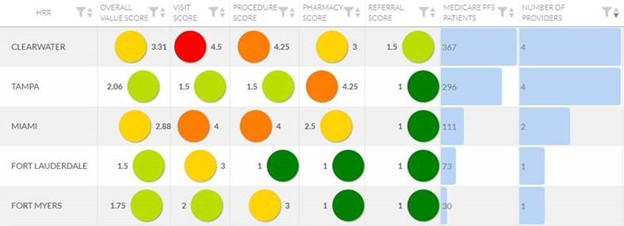Cotiviti's Signature Series features interviews with senior health plan leaders on how to improve clinical and financial outcomes in healthcare.
To successfully transition from paying for volume to paying for value, Medicare Advantage plans must take a more innovative approach to provider engagement, supporting providers with the tools and data they need to understand what comprises high-value care and succeed in value-based incentive programs.
In a recent webinar, two senior medical directors with Florida Blue Medicare, Dr. Paul Kaplan and Dr. Cupid Gascon, explained how their organization has aligned with primary care providers on education and referral efficiency, using data and collaboration to achieve membership growth and implement a successful value-based care strategy that goes beyond quality, utilization, and cost. As part of this process, the health plan uses Cotiviti’s Network Intelligence solution, which enables payers and providers to collaborate to create and manage value-based healthcare delivery and payment.
How does Florida Blue view their partnerships with primary care providers to be integral to success?
Dr. Paul Kaplan: The whole relationship that a health plan has with its members is predicated on driving the member to the appropriate physician for the right care. This whole foundational aspect fails if the health plan does not have a good relationship with its doctors. Engagement with the physicians is key. While the rules are straightforward, doctors still need to be educated on them and how to succeed. A wise health plan works with its physicians because when the doctors are profitable, the health plan's profitable. When the members are happy, everyone is happy. Engaging the physicians and showing them actionable opportunities to improve truly drives an engaged partnership. It should be a partnership where you trade ideas and talk about opportunities—it’s what the future of healthcare is about.
Watch our webinar with Dr. Kaplan and Dr. Gascon to learn more about collaborating with providers to improve value-based care.
Can you explain the criteria that you found necessary for discussion with the primary care groups to generate their buy-in and create useful discussions?
Dr. Cupid Gascon: First and foremost is the hunger for actionable data, both at the group and the individual provider level. A year-end performance summary of the group is great, but if you can't determine the root cause of either the final outcome or the variability within that final outcome, then it's not giving actionable information. The information needs to be transparent and the methodology needs to be transparent. And it needs to be conveyed in a way that’s visually interesting.
The visualization of the hard data gives us an opportunity for storytelling that conveys their performance in relation to the other practices or groups around them. And when comparing, it’s key to remember that we define peers within the same geographic region, because practice behavior is both geographic- and practice-specific.

Figure 1. Network Intelligence geographical report (sample data).
Dr. Paul Kaplan: As Dr. Gascon said, providing data on similar geography is very powerful. It's important to always remember that it’s rare to find a situation where a doctor is at the red (low-value) end of the spectrum. It's never going to happen that the doctor is inefficient at everything, but to be able to point to what it is that they have as an area for opportunity and improvement is very important.
The other thing to consider is that the audience changes periodically. If there are a hundred doctors in a group, the chief medical officer (CMO) needs to be able to simplistically identify the problems that each has, relative to their peers. When talking to the individual doctors, they are going to be very hungry to see how they stack up relative to other doctors in the practice and other doctors in the same town. This is extremely valuable information.
The other side of all of this data is that it gives the payer and the group confidence when they see their doctors at the green (high-value) end of the spectrum and know they're practicing value-based medicine. They’re being efficient, and there are many ways that the data can be used to bind the group to the payer in a way that creates a relationship of trust.
And if things need to be corrected, the most important question to ask is: how easily can you identify where those opportunities are? I always speak to physicians about grains of sand on the beach--as the payer, we are looked to by the physicians to say, "Which grain of sand do I need to pick up and improve, because I cannot fix the entire beach?" The transparency and availability to dive deep into the data becomes real very quickly when dealing with contracting.
What are some of the most memorable interactions that you have had in your discussions with primary care groups?
Dr. Paul Kaplan: Doing this work is fun because the feedback is always positive. The primary care groups are impressed by a few things: number one, the depth of the thought that goes into presenting the information, or how we present the information. They're beginning to see how their doctors compare to other doctors in the community. And the CMO can begin to see how each doctor is behaving relative to their peers in the same group. It makes the doctors eager to know what to do next, how to best use this data to be actionable, to be more involved in the way they deliver healthcare and improve the bottom line of their finances as a medical group.
Most groups have gravitated toward referrals. It's the easiest thing for a primary care doctor to change who they refer to. It's been eye-opening to see that the primary care doctors often had no idea how efficient the specialists are to whom they refer patients. Being able to see how a specialist behaves and see that they maybe had opportunities to refer to more efficient doctors is revealing and something that they can improve.
There are other primary care doctors who are employed by a large health system and are expected to refer to their own employed cardiologists or pulmonologists. My response is, "Let's have a discussion together with that cardiologist. Let's show the cardiologist where they are in the red." If they learn that 80% of all other cardiologists in this geography are practicing more efficiently than they are, they can begin to tweak some things because they might not have realized that they were red in certain areas.
The whole referral issue is the biggest takeaway we've had and, interestingly, out of the all the groups that I have spoken to, every single one has asked for follow-up meetings to review the referral data, because they want to make changes and coalesce around referring to a select group of specialists. Once they understand the theory and these colors of green through red, they can see who their problem doctors are and what it is that's driving their behavior.
Dr. Cupid Gascon: Yes, the feedback has been extremely positive because of the epiphany of finally being able to see a level playing field where performance is viewed not with the blinders of one particular health plan vs. another, but across the board.
It's the foundational premise that a physician's behavior doesn't really change from health plan to health plan, from members subscribed from one product to another, but rather that their behavior really is a generalizable pattern that’s visible in the data. This dataset and the analysis derived from it through Cotiviti really exposes that big epiphany. The other epiphany is that a provider can use this across the board in all their arrangements to give that data point or reference point on their group's performance and the individual provider's performance in any risk arrangement. I think that's the biggest takeaway from the providers we've interacted with thus far.
You've talked about how the methodology is useful and how you go in and explain it. Can you describe the biggest benefits of having this data, these scores based on a particular methodology versus coming in with just flat metrics?
Dr. Cupid Gascon: With that, I will need to lean on Aristotle who said that “the whole is greater than the sum of the parts,” and this is really what it is. We can analyze a provider's performance through a thousand metrics, but what is the integration? What is the story? This is part of that process where the biggest advantage of the Cotiviti methodology is that foundationally, the metrics are based on facts of standard, acceptable evidence-based medicine, utilization metrics, and quality-related metrics, using Choosing Wisely, looking at the deviation from the norm in utilization.
We need to roll up the facts to give a compelling holistic analysis of the provider in the different dimensions of visits, intensity, of pharmacy for referral management, and all the other dimensions of practice that are very diverse. We only show things that are relevant to a certain specialty, or group of providers practicing in that pattern. Metrics are great at face value, but what is even better is the integration of all these evidence-based, utilization-based, claims-based metrics to an overall value concept that permeates across different domains of practice.
The other point is that although there is a story to tell, that story needs to be challenged by the facts. For example, perhaps a provider or a provider group may not fare so well for referring to an outpatient facility, but in that situation, there might be only one community hospital. It's that community hospital's performance that drags down that provider or provider group's overall value score. By going down to discrete measures and comparing them to the reality or resources that are available, it may explain why certain providers or provider groups are getting that score. And, to Dr. Kaplan’s point, if a primary care physician (PCP) is asked to refer to their internal group's specialist and maybe they can only refer to one hospital, why not have that conversation with that one hospital?
We tend to forget healthcare delivery is a team sport, and it's not just as a PCP group. PCPs need to try to make that change permeate across their community.
Dr. Paul Kaplan: And it’s not only about showing a doctor where they have opportunities to improve—sometimes it's a case of showing them areas where they are doing unbelievably well. The story has to be balanced, and that is part of the provider engagement. We don't want ever to come across as beating people up, we want to balance things out, and then gently steer towards the areas where the improvement can happen.
Cotiviti’s Network Intelligence solution helps payers and providers collaborate to create and manage value-based healthcare delivery and payment.
What do you think are your biggest priorities for the next year? And how do you think provider group interaction and education will lead to sustained success for Florida Blue?
Dr. Paul Kaplan: We have three main priorities right now. First, evaluate the PCPs and their referral patterns. As we’ve said, 100% of all the groups that we've spoken to and given their unique data want that to be their first deep dive. Second, part two to identifying the referral patterns is working with some of those specialists and sub-specialists, so that they can identify where they have opportunities to improve. And third, exploring how we can use our own internal data to help support what the physicians are doing, so that they can see more real-time results.
In terms of this long-term success, I think success in the short term is that when we give doctors a report, and then we give them the same reports a few months or a year later, they look at it and they come back, and they ask questions. Engagement around the report is key. The relationship starts with them asking us to come back, so that we can strategize about the one or two things that we've picked out that we believe we need to work on to improve, and that's how we build a rapport. And whenever we speak constructively, there's no room to argue. We believe that sharing data that we all understand and can all look at and collaborate on improving—that’s the foundation for a very solid relationship.
Dr. Cupid Gascon: I would go further and say that as part of the partnership, we need to define that performance improvement plan. We need to formalize that compact that we are committed to the facts, we are committed to the methodology, and that we are willing to commit with effort and time towards that improved goal. Beyond a simple discussion, we do need to move together in partnership with a performance improvement plan.
The provider/health plan relationship hasn't been that smooth historically. That is why, to be honest, Florida Blue Medicare is coming from a standpoint that we need to prove ourselves to be a trusted partner. We’re not coming with another skewed analysis based on our health plan’s perspective of your performance; rather, we're coming from an unbiased, publicly available dataset that reflects what their practice pattern has been through a volume of beneficiaries over time. It's non-judgmental—it's just about the facts.
When a problem is brought to your attention, you want to fix it. From the health plan side, even though we see the results, we need to understand the reality of the day to day with that collaborative partner. Asking “Why is this data element, this metric showing the way it is? Help us understand.” And that's where you develop a trusting relationship. As a Florida Blue Medicare health plan, we want to grow membership, but we know that we cannot grow membership if you do not trust us.
I think that's the same perspective for any other health plan who would be willing to show unbiased datasets like this.
For health plans looking to improve their collaboration with providers, Cotiviti’s Network Intelligence solution can help. Network Intelligence helps payers and providers come together to create and manage value-based healthcare delivery and payment that aligns with this innovative new approach to medical economics. Get started recognizing and rewarding providers for performing high-value care while improving collaboration with your provider network.

.jpg)




